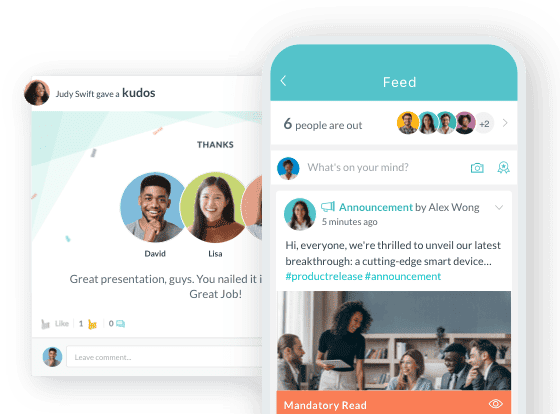Top 10 Healthcare HR Challenges That Right HR Platform Can Solve
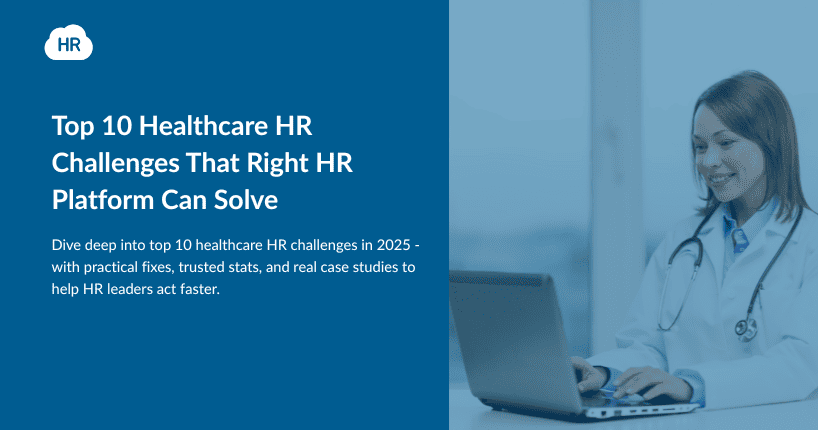
- High Turnover Among Clinical Staff
- Credential Tracking and Compliance
- Administrative Overload in Onboarding
- Poor Internal Communication
- Employee Burnout and Engagement Gaps
- Scaling Rapid Hiring
- Data Security and HIPAA Compliance
- Offboarding and Knowledge Retention
- Multi-Location Workforce Management
- Limited Analytics for HR Decisions
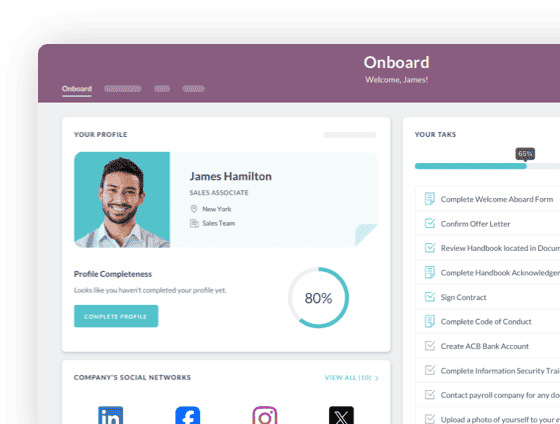
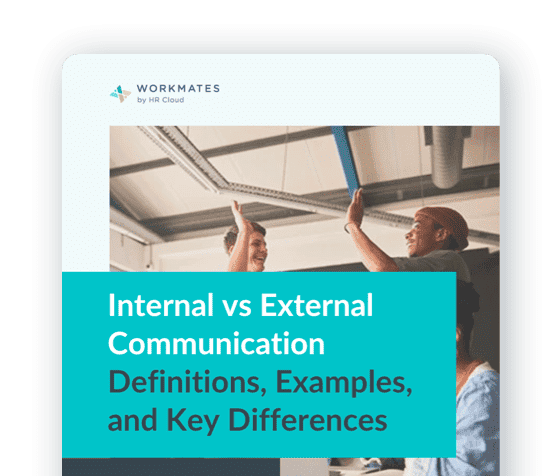
 Cut onboarding time
by 60%—here's the
Ultimate Checklist
that helped do it.
Cut onboarding time
by 60%—here's the
Ultimate Checklist
that helped do it.
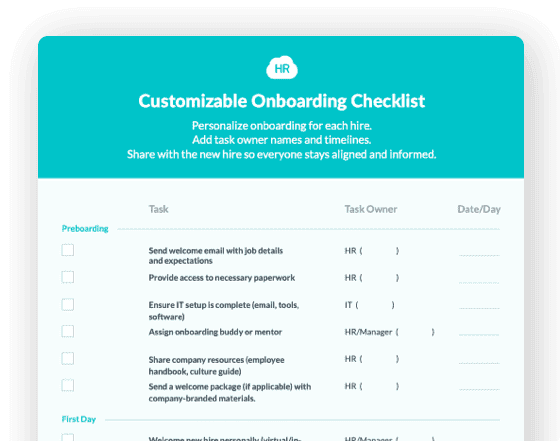
Healthcare HR teams in 2025 face mounting pressure. A 2025 NSI survey found average hospital turnover rates was 18.3% in 2024, costing millions annually in replacement and overtime. Add to this the compliance maze — HIPAA, OSHA, Joint Commission — and it’s obvious why many healthcare HR departments are overwhelmed.
For every nurse, physician, technician, or therapist, HR needs to be on top of their credential checks, background screening, and onboarding. Yet many still rely on spreadsheets and emails for these tasks. This stack may work for very small teams but collapses when faced with demands of a larger workforce.
But the good news is that you have all-in-one HR tools in the market designed specifically to meet healthcare HR needs. The complete lifecycle of each employee from recruitment and pre-onboarding screening to credentials tracking and offboarding.
As a visionary HR leader you should adopt these tools to move from firefighting to foresight, predicting risks and preventing them before crises hit.
In this article, we’ll explore 10 urgent HR challenges in healthcare and show how forward-looking organizations are solving them. You’ll also see case studies from providers who modernized with HR Cloud, like Behavioral Progression improving retention, Interim Healthcare thriving across 300 independently owned franchises, or Renaissance Outpatient Rehabilitation Center saving $75K annually. All with the help of HR tools that solve their unique challenges.
Let’s begin with the challenge every healthcare HR leader dreads: high turnover.

1. High Turnover Among Clinical Staff
Few issues keep HR leaders up at night like turnover. A hospital losing even 20% of its nurses each year struggles to maintain patient care quality and operational stability. The reality is often worse. According to the 2025 NSI National Health Care Retention Report, the average hospital turnover rate stood at 18.3%, with some specialties exceeding 25%. The average cost of replacing a registered nurse is approximately $61k.
But then turnover doesn’t just hurt the bottom line. It affects morale, increases burnout for those who stay, and undermines patient safety. Research published in the Journal of Nursing Administration shows a clear correlation between higher turnover and lower patient satisfaction scores.
Solution: Automated Onboarding & Engagement
Start strong with perfect onboarding and recognition. Employees who feel welcomed, supported, and connected in their first 90 days are far less likely to leave. Structured onboarding programs, paired with early recognition, have been shown to cut turnover by up to 50%.
How HR Cloud Helps
HR Cloud’s Onboard platform reduces “day one chaos” by digitizing forms, automating compliance tasks, and giving new hires a clear roadmap. If you couple it with Workmates, an employee engagement platform, employees receive early recognition, keep engaged, and stay longer.
Case in Point
Behavioral Progression, a healthcare service provider, used HR Cloud to streamline onboarding and create a culture of support. They cut down on new hire onboarding time from 4 weeks to 2.5 weeks, with 60% reduction in procedural queries from new hires.
Turnover may be inevitable in healthcare, but there are ways to prevent new employees from leaving early. Investing in structured onboarding and recognition is one such way and delivers on financial savings as well as stronger patient outcomes.
2. Credential Tracking and Compliance
Credential lapses are more than paperwork errors. They can obstruct patient care, block billing, and trigger citations. The Joint Commission requires documented credentialing and privileging processes regularly, during initial as well re-appointment.
Despite the mass digitization of workflows across industries, many healthcare teams still rely on manual checks and spreadsheets. And it’s not just a hunch but based on data.
A 2024 payer-credentialing report found nearly 52**%** of the surveyed providers depend on manual credential tracking processes. Which creates delays, gaps, and last-minute scrambles before audits. When expiry dates live in email threads, compliance is bound to suffer.
A clinician may be scheduled with an expired license. Payer enrolment can stall when documents are missing. And when auditors ask for primary-source verification and quick proof, manual systems struggle to respond in real time.
Solution: Centralize and Automate.
You need to digitally capture every license, certificate, and expiry date at hire, maintaining scanned proofs and primary-source checks in one searchable file. And trigger reminders at 90/60/30 days before credential expiry. The system should escalate automatically if someone misses a renewal.
How HR Cloud Helps
HR Cloud’s Onboard captures credential data during hiring. It runs renewal workflows and sends timed reminders. Dashboards surface upcoming expirations and high-risk roles. That visibility turns reactive firefighting into planned renewal cycles.
Case in Point
Interim HealthCare SLC moved from paper processes to HR Cloud because they needed a better way to replace their manual, paper-based recruiting, onboarding and employee engagement systems. Their owner Michael Hawkins says Onboard gave them confidence to place new hires in the field right away without worrying about compliance.
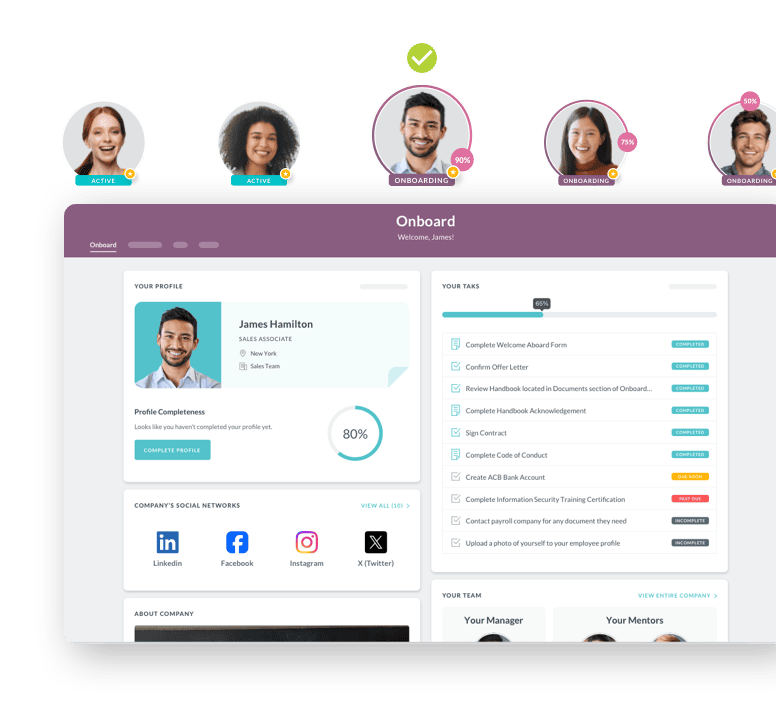
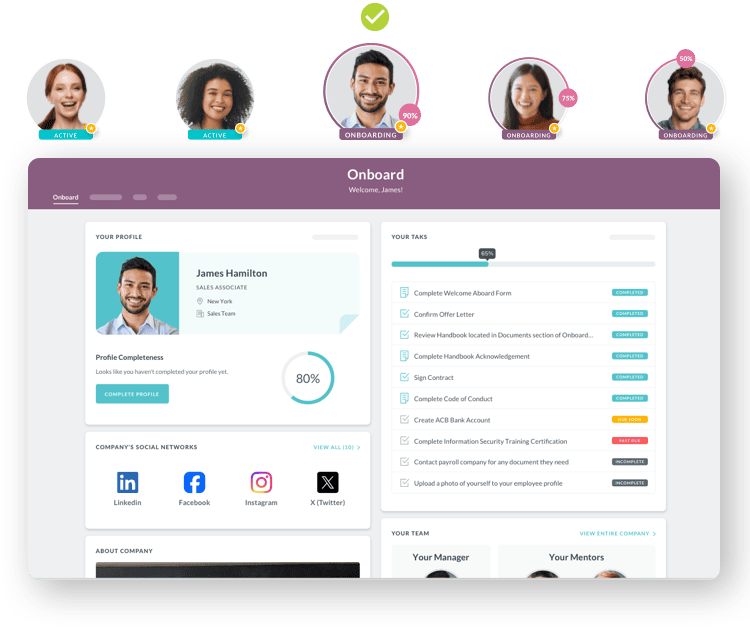
3. Administrative Overload in Onboarding
Paperwork and admin tasks can drag onboarding down. For HR teams that do not use the right onboarding platform that works, every hire creates dozens of manual touchpoints. HR teams re-key the same data across systems. Managers chase missing forms. New hires wait for access, badges, and training.
This slow churn costs time and money when strong onboarding can measurably lift retention and productivity.
Solution: Automate, Not Overload
Brandon Hall Group’s research highlights that organizations are investing in onboarding improvements. Using an onboarding platform helps:
-
Remove friction with digital checklists and e-signatures
-
Send pre-boarding forms before day one.
-
Auto-assign tasks to HR, IT, and hiring managers.
-
Use conditional workflows for role-specific requirements.
-
Kiosk and mobile-first flows speed field hires.
-
Integrate onboarding with payroll and HRIS to avoid double entry.
How HR Cloud Helps
HR Cloud’s Onboard centralizes tasks, documents, and e-signatures. Templates become repeatable checklists for every role and location. Kiosk mode enables hiring and verification in the field. Automations nudge new hires when they slack and escalate overdue items.
Case in Point
All About Kids moved from paper onboarding to HR Cloud and automated its document collection and compliance tasks. The new process reduced missed documents and sped placements, while improving the candidate experience.
 — Jesse Rose,
— Jesse Rose,Onboarding and Compliance Manager


4. Poor Internal Communication
Poor internal communication in healthcare is dangerous. It leads to missed handoffs, confused teams, and patient harm. The Joint Commission identifies handoff and communication failures as a frequent root cause of sentinel events.
Communication breakdowns can happen in multiple ways. Think shift changes. Inter-department transfers. Policy updates buried in long emails. Clinicians miss protocol changes. Managers assume others have read critical alerts. These lapses slow care and raise risk. A recent review links poor communication to a large share of serious medical errors.
Solution: Keep Communication Simple
Make communication simple, targeted, and mobile-first. Push short, role-specific alerts rather than long emails. Use structured handoff tools for transitions of care. Create targeted channels for location- or role-based updates. Measure read rates and follow up automatically. Train leaders to use brief, consistent formats for safety-critical messages.
How HR Cloud Helps
Workmates centralizes communications in one app. You can target messages by location, role, or team. Push notifications reach mobile-first clinicians. Built-in polls, pulse surveys, and analytics show who read and engaged. Recognition and micro-updates keep morale high. The result: fewer missed messages and faster operational alignment.
Case in Point
Endeavor Schools used Workmates to connect 3,400+ employees across 14 states. Targeted channels replaced inconsistent email blasts. The HR team reports higher engagement and clearer, faster internal communications. That same pattern of results applies to multi-site healthcare providers using targeted comms to reduce errors and confusion.
 — Andrea Bermudez, Organizational & Talent Development Manager
— Andrea Bermudez, Organizational & Talent Development Manager 

5. Employee Burnout and Engagement Gaps
Burnout in healthcare is widespread and damaging but there is no respite in sight. Because according to a 2023 study, globally there is a shortage of 5.9 million nurses and 4.3 million doctors.
Clinicians work long shifts. They face emotional strain and heavy workloads. Burnout links directly to lower quality of care and patient dissatisfaction. A systematic review and meta-analysis found nurse burnout is associated with worse patient safety and lower satisfaction.
As per Medscape Physician Burnout and Depression Report 2024, job stress is the biggest culprit of high rates of burnout among clinicians. Many report depression, exhaustion, and intent to leave. These trends raise turnover and raise operational risk.
Solution: Measure and Iterate
Measure engagement often and act fast. Run short pulse surveys and skip long, once-a-year questionnaires. It is more important to have the pulse of a short-term challenges. Train managers to hold regular one-to-ones and build recognition into daily routines. Reduce unnecessary admin work that steals time from patient care. If possible, offer flexible schedules. Provide clear career pathways and access to mental-health support.
Small, repeated actions beat rare, big gestures.
How HR Cloud Helps
Workmates makes recognition easy. Peers and managers can give quick kudos, badges, and points. That normalizes appreciation and keeps morale visible. Pulse surveys gather snapshots of wellbeing and measure trends over time. Analytics show which teams or sites are slipping so that you can take preemptive action.
HR Cloud automations remove repetitive admin tasks. Less admin means more time for clinical work. These shifts reduce job stress and prevent early exits.
Case in Point
Interim HealthCare SLC modernized onboarding and engagement with HR Cloud. They replaced manual, paper processes with digital checklists and automated reminders. The solution also provided a platform for faster recognition and clearer communication across distributed frontline teams.
6. Scaling Rapid Hiring
Rapid hiring bursts happen when demand spikes, mergers occur, or seasonal care needs rise. These surges overwhelm HR teams because manual processes collapse under volume. Recruiters re-key data. Managers scramble to credential and onboard groups. Hiring bottlenecks delay patient care and inflate reliance on costly agency staff.
Healthcare has seen large hiring volumes in recent years. Hospitals have added hundreds of thousands of roles while turnover remained high. That combination creates surges from recruitment to offboarding that paper-based workflows cannot handle.
Solution: Design for Volume, Not Exception
Treat high-volume hiring like a product. Map every step from offer to first shift. Automate repetitive tasks: offer letters, forms, I-9s, background checks, and badge requests. Use templated role-specific checklists. Enable preboarding so hires finish admin before day one. Provide mobile-first onboarding for field and per-diem staff.
Finally, integrate recruiting, HRIS, and payroll to prevent duplicate work. These shifts cut time-to-productivity and reduce agency spending.
How HR Cloud Helps
HR Cloud centralizes the recruit-to-onboard flow so teams scale without extra heads. Configure templates for mass hires and reuse them. Automations assign tasks to hiring managers, IT, and compliance teams. Mobile kiosks and preboarding portals let field hires complete forms before arrival. Integrations sync data to payroll and HRIS, eliminating re-entry. Dashboards track cohorts, showing who’s cleared and who needs follow-up.
Case in Point
Veolia faced complex, field-based onboarding across 10k+ field employees. They used HR Cloud Onboard to create a mobile-first process and automated workflows. The system they implemented matched their complexity and scale, without overwhelming HR teams or end users. To support a distributed team, Veolia developed manager training presentations, help guides, and messaging templates, ensuring every user had the information they needed to complete tasks efficiently.
7. Data Security and HIPAA Compliance
Healthcare holds the most sensitive data. A breach disrupts care, invites fines, and destroys patient trust. The average cost of a data breach climbed to $4.88M in 2024, with healthcare among the costliest sectors.
Meanwhile, the HHS Office for Civil Rights continues active HIPAA enforcement and corrective actions. OCR resolutions often require changes to policies, training, and monitoring. HHS.gov
Solution: Non-Negotiable Security
Protect data at every step. Encrypt data at rest and in transit. Use multi-factor authentication and role-based access control. Log and review access. Run regular risk analyses and vendor assessments. Train staff on phishing, secure messaging, and device hygiene. Treat security as an operational discipline, not a one-time project. For high-risk operations, assume an incident will happen and plan your response ahead of time.
How HR Cloud Helps
HR Cloud claims SOC 2 compliance, encryption, and enterprise controls for access and auditing. Those controls reduce the risk of exposed PHI in HR files. HR Cloud also supports secure digital I-9 and document handling, so identity/eligibility steps do not push sensitive data into email or local drives.
Case in Point
Renaissance Outpatient Rehabilitation Center moved its training and compliance tasks onto HR Cloud to gain “compliance peace of mind” and measurable savings. With Onboard they deliver role-specific training (PDFs and video), capture completion records, and keep employee files audit-ready.
 — Travis French, CEO
— Travis French, CEO 

8. Offboarding and Knowledge Retention
When clinicians leave, two things happen quickly: access risks rise and institutional knowledge walks out the door. Poorly managed exits leave active accounts, exposed access tokens, and undocumented critical know-how. SHRM warns that offboarding affects retention, security, and operational continuity.
Solution: Systemize Offboarding
Standardize offboarding with checklists and timelines. Revoke system access on day one of separation. Capture role-specific knowledge before exit: shift notes, SOPs, privileges, and vendor contacts. Use short handover meetings and recorded walkthroughs for critical tasks. Convert tacit know-how into playbooks.
Finally, use exit interviews as structured data for root-cause analysis and process improvement.
How HR Cloud Helps
HR Cloud automates offboarding workflows. Task cascades revoke access, trigger equipment returns, and notify IT and payroll in the right order. The platform stores exit notes and attachments in employee records. That creates an auditable trail and a searchable place for handover documents. Automations also ensure that compliance steps (final pay, COBRA, benefits) run without manual chasing.
Case in Point
Medlinks Cost Containment, Inc. modernized its staffing workflows with HR Cloud to scale recruiting, onboarding, and workforce administration. Medlinks used Onboard and the ATS to standardize checklists, reduce manual follow-ups, and centralize documentation for seasonal and contract hires. The team credits HR Cloud with faster verifications, easier record retrieval, and better control over temporary staff lifecycle events.
9. Multi-Location Workforce Management
Running HR for one clinic is hard. Running HR for five clinics is harder. Different sites mean different schedules, local rules, and unique staffing mixes. That complexity magnifies errors. Communication gaps widen and scheduling conflicts multiply.
The American Hospital Association’s Workforce Scan found rising stress across settings and shows how distributed care increases turnover risk and operational friction.
Solution: Create One Source of Truth
Centralize employee records, schedules, and credentials. Standardize role checklists while allowing site-level exceptions. Use targeted communications for location-specific updates.
Give managers a dashboard showing staffing, open roles, and compliance gaps for their site. Run regional reports weekly. Automate local approvals and badge or equipment requests so field teams don’t wait for corporate HR.
How HR Cloud Helps
HR Cloud centralizes people data across locations. Its People and Onboard modules store role templates, credential proof, and documents in one place. Workmates provides targeted channels so site leads get only relevant updates.
Automations assign tasks to local managers, IT, and HR automatically. Dashboards show site-level compliance, active hires, and pending tasks. Turnkey integrations sync this data to payroll and scheduling systems to avoid double entry.
Case in Point
Great Kids & Awesome Adults streamlined hiring and onboarding across multiple centers. They centralized applicant tracking and onboarding checklists with HR Cloud. The result was more applicants, faster interviews, and cleaner placements across sites. See their HR Cloud case study for measurable improvements.
10. Limited Analytics for HR Decisions
Many HR teams fly blind. They guess where shortages will appear and react to problems rather than forecast them. That increases reliance on expensive agency staff. Large systems now use predictive analytics to reduce contingent labor and optimize schedules. Geisinger’s playbook and examples show analytics cut over-staffing and reduce wait times.
Solution: Start With Clean Data
Consolidate hires, time-to-fill, turnover, credentials, and engagement scores in one dataset. Define the KPIs you care about: time-to-fill, agency spend, unplanned absenteeism, credential risk, and new-hire ATO (ability to operate).
Build dashboards that answer exact questions managers ask. Use short-window forecasts (7–30 days) to plan shifts, and longer forecasts (90–180 days) for workforce planning.
How HR Cloud Helps
HR Cloud collects onboarding, credential, and engagement data in a single platform. Built-in reports show overdue tasks, expiring credentials, and hiring bottlenecks. Export options and integrations let you feed the data into BI tools for advanced modeling. Use cohort views to compare hires by source, role, or location. Those views convert gut calls into measured bets.
Case in Point
Fortenova rolled out Workmates across 30+ companies and 40,000+ employee profiles, then used HR Cloud’s analytics to measure adoption and impact in real time — including 97% monthly active usage, 59% mobile-app adoption, and a 21% reduction in all-staff emails, metrics that proved both scale and engagement.
The value was not just the raw numbers but the depth of insight. HR Cloud surfaces MAU/DAU, mobile adoption, channel-level read and engagement rates, recognition activity, and campaign performance, all broken down by company, location, and language so leaders can segment results and act where it matters.
Next Steps
There is no doubt that healthcare HR cannot afford partial fixes. The NSI retention data shows turnover remains a costly, recurring drag on budgets and care teams. Manual tracking and siloed data cost money, time, and patient safety.
The answer is to centralize people data, automate credential and onboarding workflows, and put analytics where leaders make decisions. Technology will do the heavy lifting so HR can help support the staff in caring for patients.
And the best part is that the tools will not even be a drain on the budget. The CAQH Index estimates that healthcare organizations can save 22% of current admin spending by shifting from manual to automated processes.
The logical next step from here is to start looking at modern HR platforms like HR Cloud that can be customized fully for healthcare needs.
 Discover how our HR solutions streamline onboarding, boost employee engagement, and simplify HR management
Discover how our HR solutions streamline onboarding, boost employee engagement, and simplify HR management
FAQs
What are the biggest HR challenges in healthcare today?
Healthcare HR primarily faces staffing shortages, regulatory burden, burnout, and fragmented systems. Recruiters juggle high turnover while compliance teams chase credentials. These problems compound across multi-site networks, raising costs and risking patient safety.
How can hospitals reduce nurse turnover?
Hospitals can cut nurse turnover by fixing the early experience and workload. Structured onboarding, predictable scheduling, mentorship, and reduced mandatory overtime improve retention. Financially, replacing an RN costs tens of thousands per person, so prevention is literally better than cure.
What is provider credentialing and why does it matter?
Provider credentialing verifies licenses, training, and privileges before clinicians treat patients. It enhances care quality, supports payer enrollment, and prevents citations during audits. Centralized, auditable credential records speed verification and reduce billing delays.
How long should onboarding be in healthcare for best results?
Onboarding should definitely extend beyond day one. A practical window is three to six months, with focused touchpoints in the first 90 days. Staged learning, mentor check-ins, and role-specific checkpoints raise competence and retention. If you want to dive deeper, read this Ultimate Employee Onboarding Guide.
What is workforce analytics in healthcare and how does it help HR?
Workforce analytics combines hiring, turnover, scheduling, credentialing, and engagement data into one dataset. Analytics enables HR to spot staffing gaps, predict agency needs, and measure program ROI. Teams using analytics reduce contingency spend and improve planning.
How can healthcare organizations improve internal communication to reduce offboarding errors?
The first step towards improving internal communications to reduce errors is to standardize handoffs and use targeted, mobile-first communications. Structured handoff tools, short role-specific alerts, and read-receipt analytics cut missed messages. The Joint Commission links handoff failures to many sentinel events; targeted comms and handoff tools substantially reduce risk.

Keep Reading
From Manual to Automated: A Complete Guide to Digitizing Employee Onboarding for Large Organizations
Sarah Chen, Director of HR at a 7,000-employee healthcare organization, starts her Monday
Enterprise HR Software in 2025: Why Traditional Enterprise Platforms Fall Short and What Actually Works
Traditional enterprise human resources software systems promise comprehensive solutions
AI in Onboarding: Complete Guide for 2026
You’ve probably been hearing this multiple times a day — AI is transforming HR. But
Like What You Hear?
We'd love to chat with you more about how HR Cloud® can support your business's HR needs. Book Your Free Demo

Build a Culture of Recognition. Boost Engagement. Guaranteed.
Workmates empowers employees to stay informed, connected, and appreciated—whether they’re on the front line, in the office, or remote. Recognition drives 12x higher engagement.Trusted by industry leaders in every sector




Cut Onboarding Costs by 60%.
Take the confusion and follow-ups out of onboarding with automated workflows, digital forms, and structured portals—so new hires ramp faster 3X quicker.Trusted by industry leaders in every sector




